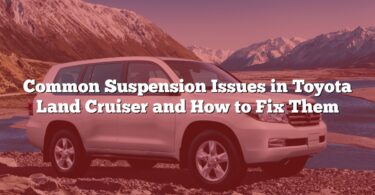Starter motor problems in a Toyota Land Cruiser can leave you stranded and frustrated. This guide dives into the most common causes of these issues, providing clear solutions to get your vehicle back on the road. Whether it’s a weak battery, faulty wiring, or worn-out components, understanding these problems and how to address them is key to maintaining your Land Cruiser’s reliability. Let’s explore the practical steps to identify and resolve these issues effectively.
Comprehensive Guide: Resolving 35 Starter Motor Issues in a Toyota Land Cruiser with 35 Solutions
| N° | Problem/Cause | Possible Solution |
|---|---|---|
| 1 | Weak or dead battery | Recharge or replace the battery. Check for proper terminal connections. |
| 2 | Faulty starter motor | Replace or rebuild the starter motor. |
| 3 | Damaged starter solenoid | Replace the solenoid or rebuild the starter assembly. |
| 4 | Worn-out starter relay | Replace the starter relay. |
| 5 | Loose or corroded electrical connections | Clean and tighten all electrical connections. |
| 6 | Faulty ignition switch | Test and replace the ignition switch if faulty. |
| 7 | Blown fuse in the starter circuit | Inspect and replace the blown fuse. |
| 8 | Bad ground connection | Clean and secure the ground connection. |
| 9 | Faulty neutral safety switch | Replace the neutral safety switch. |
| 10 | Faulty clutch safety switch | Replace the clutch safety switch. |
| 11 | Worn-out starter gear (Bendix drive) | Replace the Bendix drive or rebuild the starter motor. |
| 12 | Faulty or misaligned flywheel teeth | Inspect and replace damaged flywheel teeth. |
| 13 | Excessive oil or grease contamination | Clean the starter motor and address the source of contamination. |
| 14 | Overheating of the starter motor | Allow the motor to cool; avoid prolonged cranking. Inspect for internal damage. |
| 15 | Damaged or frayed wiring in the circuit | Repair or replace damaged wiring. |
| 16 | Low voltage in the electrical system | Test and charge the system battery. Check alternator performance. |
| 17 | Defective alternator | Replace or repair the alternator. |
| 18 | Mechanical obstructions in the engine | Inspect the engine for obstructions and resolve mechanical issues. |
| 19 | Poor quality aftermarket starter | Replace with a reliable OEM or high-quality starter motor. |
| 20 | Internal damage to starter armature | Rebuild or replace the starter motor. |
| 21 | Broken or misaligned mounting bolts | Replace or realign starter mounting bolts. |
| 22 | Electrical surges damaging the circuit | Inspect and replace affected components. Install surge protectors if necessary. |
| 23 | Moisture or water ingress | Dry out the starter motor and prevent future water ingress. |
| 24 | Internal short circuit in starter motor | Rebuild or replace the starter motor. |
| 25 | Worn-out or stuck starter brushes | Replace the brushes and inspect for proper alignment. |
| 26 | Faulty crankshaft position sensor | Replace the crankshaft position sensor. |
| 27 | Starter motor engages but engine doesn’t turn | Inspect starter motor, solenoid, and flywheel for mechanical or electrical issues. Replace as needed. |
| 28 | Starter motor turns but doesn’t turn engine | Inspect and replace damaged Bendix drive or flywheel teeth. Ensure proper alignment. |
| 29 | Starter motor stays on after starting | Replace the solenoid or inspect the ignition switch for faults. |
| 30 | Intermittent starter motor operation | Inspect for loose connections, faulty relay, or heat-related issues. Replace faulty parts. |
| 31 | Clicking or grinding noises when starting | Inspect flywheel teeth and starter motor for damage. Replace or repair as needed. |
| 32 | Damaged or missing starter teeth | Replace the damaged starter gear or flywheel. |
| 33 | Failure of Bendix mechanism | Replace or rebuild the Bendix mechanism. |
| 34 | High resistance in the starter circuit | Clean connections and test the circuit. Replace damaged components. |
| 35 | Thermal expansion affecting solenoid | Replace the solenoid with a heat-resistant variant if necessary. |
Detailed Guide: Resolving 35 Starter Motor Issues in a Toyota Land Cruiser with 35 Solutions
1. Weak or Dead Battery
- Reason 1: The battery may lack sufficient charge due to prolonged use or insufficient charging.
- Reason 2: Corroded terminals may interrupt the connection.
Solution:
- Test the battery voltage using a multimeter. A healthy battery should read around 12.6 volts when fully charged.
- Recharge the battery if the voltage is low. If the battery doesn’t hold a charge, replace it.
- Clean the terminals using a wire brush to remove corrosion, and tighten the connections securely.
2. Faulty Starter Motor
- Reason 1: Internal components such as the brushes or armature may be worn out.
- Reason 2: The starter motor may have suffered physical damage or overheating.
Solution:
Replace or rebuild the starter motor. A rebuilt motor should include new brushes, bearings, and internal wiring as needed.
3. Damaged Starter Solenoid
- Reason 1: Electrical contacts within the solenoid can wear out over time.
- Reason 2: The solenoid may fail to send power to the starter motor.
Solution:
Replace the solenoid. Ensure the new solenoid is compatible with your Land Cruiser model.
4. Worn-Out Starter Relay
- Reason: The relay may fail due to excessive use or electrical damage.
Solution:
Replace the starter relay. Use the vehicle’s manual to locate and swap the relay with a compatible replacement.
5. Loose or Corroded Electrical Connections
- Reason 1: Loose connections can interrupt the current flow.
- Reason 2: Corroded terminals reduce efficiency in the circuit.
Solution:
- Inspect all electrical connections in the starter circuit.
- Tighten any loose connections and clean corroded terminals with a wire brush and contact cleaner.
6. Faulty Ignition Switch
- Reason: The switch may fail to send power to the starter relay.
Solution:
Test the ignition switch for continuity. Replace it if it doesn’t function properly.
7. Blown Fuse in the Starter Circuit
- Reason: Electrical surges or short circuits can cause the fuse to blow.
Solution:
Locate the fuse in the starter circuit. Replace it with a new fuse of the correct amperage.
8. Bad Ground Connection
- Reason: Poor grounding can disrupt the electrical flow in the starter circuit.
Solution:
Inspect the ground connection between the battery and the chassis. Clean and secure the connection to ensure proper grounding.
9. Faulty Neutral Safety Switch
- Reason: This switch prevents the vehicle from starting unless it is in neutral or park.
Solution:
Replace the neutral safety switch if it fails to transmit power in the correct gear positions.
10. Faulty Clutch Safety Switch
- Reason: This switch prevents starting unless the clutch pedal is fully depressed.
Solution:
Replace the clutch safety switch. Check the switch for alignment and secure mounting.
11. Worn-Out Starter Gear (Bendix Drive)
- Reason: The teeth of the gear can wear out, preventing engagement with the flywheel.
Solution:
Replace the Bendix drive. Ensure the new gear matches the specifications of the starter motor.
12. Faulty or Misaligned Flywheel Teeth
- Reason: Damaged or misaligned teeth prevent the starter gear from engaging properly.
Solution:
Inspect the flywheel. Replace or repair the damaged teeth, and ensure the flywheel is aligned correctly.
13. Excessive Oil or Grease Contamination
- Reason: Leaks in nearby components may contaminate the starter.
Solution:
Clean the starter motor thoroughly. Locate and repair the source of contamination, such as a leaking seal.
14. Overheating of the Starter Motor
- Reason: Prolonged cranking can cause the motor to overheat.
Solution:
Allow the motor to cool before trying again. Avoid continuous cranking for more than 15 seconds.
15. Damaged or Frayed Wiring in the Circuit
- Reason: Physical damage or wear can interrupt the current flow.
Solution:
Inspect all wiring in the starter circuit. Repair or replace any damaged sections.
16. Low Voltage in the Electrical System
- Reason: A weak alternator or poor connections can result in insufficient power.
Solution:
Test the alternator output and replace it if necessary. Tighten and clean all connections in the electrical system.
17. Defective Alternator
- Reason: A malfunctioning alternator may fail to charge the battery.
Solution:
Replace or repair the alternator. Ensure the replacement alternator matches your vehicle’s specifications.
18. Mechanical Obstructions in the Engine
- Reason: Internal mechanical failures can prevent the engine from turning.
Solution:
Inspect the engine for obstructions such as broken parts or foreign objects. Repair any damaged components.
19. Poor Quality Aftermarket Starter
- Reason: Low-quality starters may fail prematurely.
Solution:
Replace the aftermarket starter with an OEM or high-quality aftermarket unit.
20. Internal Damage to Starter Armature
- Reason: Wear and tear or electrical surges can damage the armature.
Solution:
Rebuild or replace the starter motor. A professional rebuild should include inspection and repair of the armature.
21. Broken or Misaligned Mounting Bolts
- Reason: Mounting bolts may break due to vibration or improper installation, causing the starter to misalign.
Solution:
- Inspect the mounting bolts for damage or misalignment.
- Replace broken bolts with new ones of the correct size and grade.
- Ensure the starter is properly aligned during reinstallation.
22. Electrical Surges Damaging the Circuit
- Reason: Power surges can damage components in the starter circuit.
Solution:
- Inspect all components, including the relay, solenoid, and wiring.
- Replace any damaged parts.
- Consider installing a surge protector to safeguard the electrical system.
23. Moisture or Water Ingress
- Reason: Exposure to moisture can corrode internal components and disrupt functionality.
Solution:
- Remove and dry the starter motor thoroughly.
- Clean corroded components with electrical contact cleaner.
- Install protective covers to prevent future water ingress.
24. Internal Short Circuit in Starter Motor
- Reason: Worn insulation or damaged wiring inside the starter can cause a short circuit.
Solution:
Rebuild or replace the starter motor. During rebuilding, ensure all internal wiring and insulation are inspected and repaired as needed.
25. Worn-Out or Stuck Starter Brushes
- Reason: Brushes can wear out or become stuck, reducing the motor’s efficiency.
Solution:
- Disassemble the starter motor and inspect the brushes.
- Replace worn or damaged brushes with new ones.
- Clean and lubricate brush holders to prevent sticking.
26. Faulty Crankshaft Position Sensor
- Reason: The sensor may fail to provide accurate position data, preventing proper ignition timing.
Solution:
Replace the crankshaft position sensor. Use a diagnostic tool to confirm the fault before replacement.
27. Starter Motor Engages but Engine Doesn’t Turn
- Reason 1: Insufficient torque from the starter motor.
- Reason 2: Mechanical issues like a seized engine or damaged flywheel teeth.
Solution:
- Inspect the starter motor for internal faults and repair or replace it.
- Examine the flywheel for damage and replace it if necessary.
- Check for engine seizure and resolve any mechanical issues.
28. Starter Motor Turns but Doesn’t Turn Engine
- Reason 1: Faulty Bendix drive.
- Reason 2: Damaged or misaligned flywheel teeth.
Solution:
- Inspect the Bendix drive and replace it if damaged.
- Check the flywheel for damaged teeth and repair or replace as needed.
- Ensure proper alignment during reassembly.
29. Starter Motor Stays On After Starting
- Reason 1: Stuck solenoid.
- Reason 2: Faulty ignition switch.
Solution:
- Replace the solenoid if it remains engaged after starting.
- Inspect and replace the ignition switch if it fails to disengage the starter.
30. Intermittent Starter Motor Operation
- Reason 1: Loose electrical connections.
- Reason 2: Faulty starter relay or solenoid.
Solution:
- Inspect all connections and tighten any loose ones.
- Test the relay and solenoid for faults and replace them as needed.
31. Clicking or Grinding Noises When Starting
- Reason 1: Worn flywheel teeth.
- Reason 2: Loose or misaligned starter motor.
Solution:
- Inspect the flywheel and replace it if teeth are damaged.
- Ensure the starter motor is securely mounted and properly aligned.
32. Damaged or Missing Starter Teeth
- Reason: Wear and tear or improper engagement can damage starter teeth.
Solution:
Replace the starter gear or flywheel if teeth are damaged or missing. Proper alignment during installation is crucial to prevent recurrence.
33. Failure of Bendix Mechanism
- Reason: Worn or damaged Bendix mechanism prevents proper engagement with the flywheel.
Solution:
Replace or rebuild the Bendix mechanism. During rebuilding, ensure all components are properly lubricated and aligned.
34. High Resistance in the Starter Circuit
- Reason: Corroded or loose connections increase circuit resistance.
Solution:
- Inspect and clean all connections in the starter circuit.
- Replace any damaged wiring or connectors.
- Test the circuit for resistance using a multimeter to ensure proper function.
35. Thermal Expansion Affecting Solenoid
- Reason: Heat can cause the solenoid to expand, preventing proper operation.
Solution:
Replace the solenoid with a heat-resistant model. If heat is a recurring issue, install heat shields or improve ventilation around the starter assembly.
Preventing Future Issues
To avoid recurring starter motor problems in your Toyota Land Cruiser, follow these preventive steps:
- Maintain the Battery:
- Regularly check the battery voltage and ensure it remains within the recommended range (12.6 volts or higher when fully charged).
- Clean the battery terminals to prevent corrosion and ensure a secure connection.
- Replace the battery when it shows signs of diminished capacity or consistent low voltage.
- Inspect Electrical Connections:
- Periodically check all electrical connections in the starter circuit for looseness or corrosion.
- Tighten connections and clean terminals with contact cleaner and a wire brush.
- Protect Against Moisture:
- Avoid driving through deep water or in conditions where the starter motor may be exposed to excessive moisture.
- Use protective covers or shields to safeguard the starter motor from water ingress.
- Monitor Engine Performance:
- Ensure the engine is running smoothly to reduce strain on the starter motor.
- Address engine-related issues promptly, such as misalignments or mechanical obstructions.
- Limit Prolonged Cranking:
- Avoid cranking the engine for more than 10-15 seconds at a time.
- Allow the starter motor to cool between attempts to prevent overheating.
- Use Quality Replacement Parts:
- When replacing the starter motor or its components, always opt for high-quality OEM or reputable aftermarket parts.
- Regular Maintenance Checks:
- Include the starter motor and related components in your vehicle’s routine maintenance schedule.
- During servicing, have the mechanic inspect the starter motor, solenoid, and relay for wear and tear.
- Install Surge Protectors:
- If your vehicle frequently experiences electrical surges, consider installing a surge protector in the starter circuit.
By following these steps, you can significantly reduce the likelihood of starter motor issues, ensuring reliable performance and avoiding costly repairs. Prevention is always better than a breakdown.







